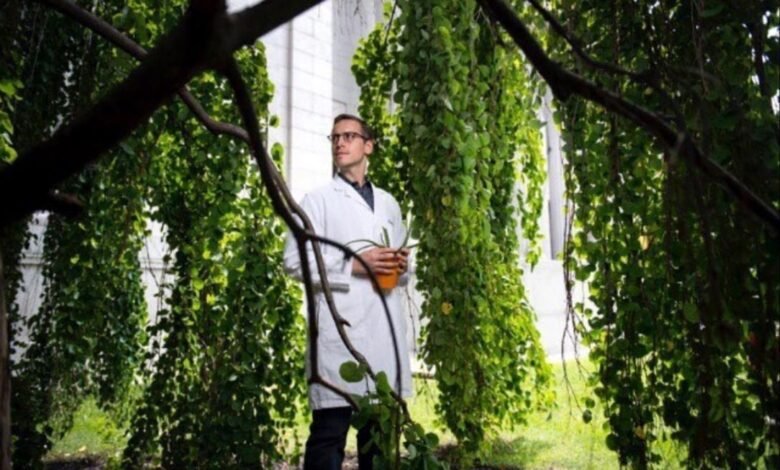Converting food tradition into science with the periodic table of foods

As a boy, John de la Parra’s idea of play involved exploring the plants and crops on his family’s small farm in Boaz, Alabama. His biggest influence was his grandmother, who introduced him to the medicinal and therapeutic properties of plants. Over time, this passion turned into a love of science, and he began to make connections between ancient wisdom and modern scientific discoveries.
Today, de la Parra lives his childhood dream as an ethnobotanist and plant chemist, as well as Director of the Rockefeller Foundation’s Food Initiative. He’s part of a revolutionary team that’s changing the way we understand food.
The truth is that we know very little about what we eat.
“For centuries, traditional societies have revered certain foods for their medicinal and therapeutic properties,” he says. “But the scientific community has only scratched the surface of understanding the biochemical composition and properties of what we consume.”
The idea that food is medicine has been central to human cultures for millennia, rooted in rich histories and intricate belief systems. Traditional societies have meticulously passed on knowledge about the medicinal properties of specific foods through generations. As we move into an era of evidence-based practices, we find ourselves at a fascinating crossroads: investigating ancient traditions to uncover scientific truths while honoring the cultural contexts that gave rise to them.
João de la Parra
To be honest – if we look at the numbers – it seems like science has lagged behind.
Consider this. Our foods contain many tiny parts called biomolecules, such as proteins, carbohydrates and vitamins, that help our bodies function. However, we routinely catalog only a small fraction of these – about 150 out of a few tens of thousands, or less than 1%, to be exact.
“A substantial portion of what humanity consumes remains a scientific mystery,” confirms Selena Ahmed, Global Director of the American Heart Association’s Periodic Table of Food Initiative (PTFI). “Not only have these foods been invisible to nutritional science, but an estimated 95% of food biomolecules have escaped our analysis and do not appear on food labels. time, we have limited understanding.”
But that’s about to change.
The innovative PTFI – developed by the Rockefeller Foundation – includes a research database that captures the known and previously unknown biochemical properties or “dark matter” of foods. PTFI’s biochemical data is collected through cutting-edge technologies such as high-resolution mass spectrometry and artificial intelligence, providing a lens through which the secrets of ancient dietary wisdom can finally be scientifically validated.
PTFI’s standardized analytical methods and tools identify thousands of components in food, in laboratories … [+]
“For decades, food has been viewed through a reductionist lens, often simplified to essential calories and nutrients. PTFI promises to fundamentally change this approach for the better,” says Maya Rajasekharan, Director General for Africa of the Bioversity Alliance and CIAT and Director of Strategic Integration and Engagement at PTFI.
Supported by the American Heart Association and facilitated by the Alliance of Bioversity International and CIAT, PTFI curated an initial list of 1,650 foods from around the world, many of them prized for their medicinal properties by indigenous cultures for millennia. The scientific community has already started collecting data on around 500 of them.
PTFI data is being made available to the public through MarkerLab, an online data visualization tool. Chi-Ming Chien, developer and co-founder of Verso Biosciences, says the interface will help users visualize and explore data in a clear and informative way, allowing researchers to “compare foods and compounds of interest across the entire PTFI database to Unleash the next scientific discoveries around food, nutrition, agriculture and health.”
But like ancient wisdom, data must also tell a story.
“Human beings want to understand the natural world around us,” says de la Parra. “We’re collecting all this empirical chemical data about foods, but we’re also collecting metadata – the additional information that describes these foods, like, how were the foods grown? Where was it grown? Why is it significant? How is this food used by a certain culture? These ideas of traditional ecological knowledge and traditional knowledge are particularly fascinating. The Food Initiative Periodic Table is, in many ways, the world’s most comprehensive resource on edible biodiversity.”
John de la Parra at work
Understanding the composition of food – encompassing diverse biomolecules and their quantities under diverse conditions – is key to empowering stakeholders across the food system. This knowledge enables informed decisions that improve planetary and human health, while helping to bridge the gap between traditional wisdom and modern science.
This initiative is timely at a time when the world is facing food-related diseases and climate change. The narrow focus on a few staple crops – wheat, corn and rice – has led to a loss of dietary diversity and resilience. PTFI’s diverse food list, which includes a wide variety of fruits, vegetables, nuts, seeds, animals, and even fungi and lichens, is essential to building a more sustainable and resilient food system.
“As the number of foods in the database grows, so does our collective understanding of the role of food in human and planetary health,” says Tracy Shafizadeh, developer and director of Verso Biosciences.
Notably, more than 1,000 of the foods included in the PTFI repository are not in any globally recognized food composition database, highlighting a significant gap in nutritional knowledge.
An example highlighted by the PTFI team are acacia seeds from the Acacia genus, a traditional food of Australian aborigines. Despite their long history of use, many of the 120 species in this genus are missing from global food databases. PTFI is highlighting these neglected foods, raising important questions about their nutritional and medicinal qualities and their role in ecosystems.
Wattleseed, a traditional food of the Australian aborigines
PTFI’s efforts also resonate with broader environmental goals. As Bruce German, chair of PTFI’s Scientific Advisory Committee and director of the Foods for Health Institute at the University of California, Davis, says: “Agriculture is a major contributor to climate change and the devastation of the planet…The only way to To fix this, the necessary step, is to know what food is.”
To ensure cultural, geographic and climatic inclusivity, PTFI has established nine Centers of Excellence across all major continents, seven of which are in low- and middle-income countries, to lead food biomolecular analysis and its regional translation. These centers include the University of Adelaide in Australia, the University of California, Davis, the Ethiopian Institute of Public Health, the Kwame Nkrumah University of Science and Technology in Ghana, the Pontifical Javeriana University in Colombia, the National Institute of Nutrition and Science Doctors Salvador Zubirán in Mexico, Mahidol University in Thailand, University of the South Pacific and Wageningen University and Research in the Netherlands.
“In addition to helping collect food samples from around the world, having local institutions lead this effort ensures that people in those regions can ask culturally relevant questions about their food,” explains de la Parra. “For culturally sensitive foods, we are very mindful of how we collect and share data… to ensure that communities analyzing foods that are spiritually or culturally important to them do not have to make all of the information accessible to the public.”
The nine centers of excellence also allow comparisons to be made across contexts.
“With PTFI, our methods are standardized,” says de la Parra. “So if I analyze an apple in the US and someone in another country analyzes a different apple, we can compare apples to apples, literally.”
The implications of this work are profound. PTFI can validate traditional practices and pave the way for new evidence-based dietary guidelines. This could lead to more natural, accessible and effective health solutions, perfectly aligning with the growing interest in holistic wellness.
“There is also an opportunity for advances in personalized nutrition,” adds de la Parra. “Each of us has a genetic heritage that evolved in a specific place, eating specific foods. Knowing the chemistry of these foods can allow us to make more accurate health recommendations.”
Understanding the intricate biochemistry of food can help create a sustainable food system using a holistic approach that promotes diversity, sustainability and resilience in food production and consumption.
The Food Initiative Periodic Table is more than a scientific endeavor; it is a bridge between the past and the future, a fusion of ancient wisdom with cutting-edge technology. As we continue to explore and validate the medicinal properties of traditional foods, we open up new possibilities for global health, sustainability and well-being. This is the beginning of a new era in understanding food as medicine – an era that honors the past while embracing the future.
Chief Marcelino Apurina, from Aldeia Novo Paraíso, in the Western Amazon region of Brazil, near … [+]




